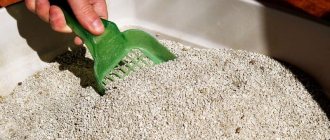If a cat marks furniture, corners and walls after sterilization, various factors may be the cause of this behavior. Most pets stop littering everywhere after surgery, but some pets become even more naughty than before. To cope with the problem, the animal will need to be trained.
Why does a cat mark its territory?
There are several reasons why a neutered cat will mark its territory.
First, the veterinarian performed the spay operation in bad faith. To ensure that the procedure went well, owners and their pets are advised to return to the veterinary clinic. Diagnostics in the form of an ultrasound will help identify the remaining parts of the ovaries. If this problem occurs, the doctor will prescribe additional surgery. But even surgical intervention carried out without errors does not guarantee the absence of tags in the apartment.
Secondly, animals are often referred for surgery already at puberty. Experts note that the reason for the preservation of marks in this case may be established sexual behavior.
Thirdly, a neutered cat may not like its environment. Rearranging the litter box, moving, the arrival of a new animal in the house, a different type of filler, changing the appearance of the rooms after renovation - all this can contribute to the pet starting to mark its territory.
How to properly process seams?
- As we said earlier, veterinarians are convinced that you should not overuse suture treatment if there is no redness or swelling in the surrounding tissues;
- Postoperative tissue swelling - the suture rises slightly above the surface of the skin. Soon the wound begins to close with light pink or white tissue. It is worth noting that it is extremely gentle, so you should avoid injuring the cat during this period of time;
- Sometimes, cats do not pay attention to the seam, but may begin to lick it profusely or even bite it. It is necessary to wrap the lower part of the cat's body with thick fabric or, if possible, sew a jumpsuit;
- It is recommended to minimize the cat's active lifestyle, since the edges of the suture can separate, which will lead to bleeding.
What is the essence of cat marks?
After sterilization, your cat can continue to do the following:
- approach a wall or furniture;
- raise your tail high and shake it;
- release a small amount of urine.
Marks in an apartment from a sterilized cat can mean protection of one’s territory, preserved sexual instinct, or discomfort when staying indoors.
If a cat lives in the neighborhood, the female senses this and marks the corners to attract an individual of the opposite sex. The rest of the time, she can simply defend the territory from foreign animals, which she senses by smell. If you are bringing a new pet into your home, be prepared to purchase a separate litter box and designate a different area for feeding. At first, you may even have to place the cats in different rooms to make the animals feel safe.
Representatives of cats may begin to mark their territory due to the appearance of strangers in the house. If you leave a sterilized cat on vacation with a person whom the pet has not seen before, she may experience stress and for this reason leave marks. If the animal is under severe stress, the veterinarian may also prescribe sedatives. Funds are also prescribed when moving to another home, renovating or purchasing new furniture. It happens that over time the pet’s behavior returns to normal without outside help.
Sometimes animals tend to leave marks when they have urolithiasis. To rule out health problems in your cat, you need to bring the animal to the veterinary clinic for examination once a year.
Caring for your cat after surgery
The postoperative period includes the period of time when the animal regains consciousness after surgery and until all symptoms of anesthesia disappear and the wound heals.
How long the postoperative period in a cat will last depends on the following factors:
- Anesthesia is divided into inhalational and intravenous. It is worth noting that intravenous is much more expensive and its administration has a number of technical difficulties, but despite this, it is considered safer and more effective.
- Pet's age. Of course, it is best to have surgery after the onset of estrus or after the first birth. Implementation at a later age or after several births is much worse tolerated and is associated with a high likelihood of complications.
- Development of pathologies. Long-term viral infections, respiratory diseases and chronic diseases affecting the gastrointestinal tract significantly complicate and increase the duration of rehabilitation.
What should the owner do?
If the owner notices that the cat has begun to mark, first he must find out the reason. If there is a medical error during sterilization or your pet has health problems, you should immediately visit a veterinarian.
If there are objective reasons related to a change of environment, the owner must be patient and do everything possible to get the pet accustomed to the new apartment or objects.
The cat should stop marking if the owner takes educational measures.
Some owners use physical punishment to train cats to use the toilet. If you scream, use a spray bottle, or deprive him of food or toys, the animal will become afraid and the actions will have the opposite effect.
Is it all because of heat?
Upon reaching the age of 6 - 8 months, hormones begin to rage. The reproductive instinct awakens and the search for a partner begins.
If an uncastrated cat lives nearby or in the neighborhood, then the cat will try to attract his attention as much as possible with the help of loud screams and marks. The most common cases are when a cat shits during heat, but the following may also be the cause:
The most common cases are when a cat shits during heat, but the following may also be the cause:
- Veterinarian intervention or sterilization: the cat marks as a result of stress. You need to leave the animal alone. Perhaps this problem will resolve itself. If the situation with the tagged property drags on, then you need to consult a veterinarian who can offer sedatives.
- Developing pathologies in the genitourinary area. - This can be cystitis, pyelonephritis, formation of stones and sand in the kidneys and ureter. In such cases, the act of urination becomes painful, and the tray begins to cause unpleasant associations. This may prompt the cat to look for another place that, in its opinion, causes less painful sensations, marking it along the way. A loving owner is obliged to show the cat to a veterinarian for consultation and further treatment;
- The arrival of a new family member or pet. The cat may perceive such an “innovation” as a threat to its territory. Instinctively, she marks everyday objects, showing dominance. If this is a person, then you need to give time to get used to each other. When a pet appears, the best solution is to temporarily isolate them. It happens that when leaving, owners are forced to leave the cat with strangers. Marks in such cases can be a sign of protest
How to stop a cat from marking in the apartment?
If you have spayed your cat and she continues to mark her territory for unknown reasons, the following measures may help:
- You need to follow the cat and catch it at the moment when it leaves a mark. You can poke your pet at the “crime scene” without in any way causing pain to the animal. This punishment can only be applied at that very moment. Over time, the animal will not understand this attitude of the owner. Reward your cat for improving behavior.
- Chemical agents will help get rid of old marks and prevent the appearance of new ones. For example, bleach, vinegar, lemon juice or special sprays sold in pet stores.
- It is recommended to reduce the calorie content of your cat's diet. The animal will become calmer if it does not have extra energy for bad behavior.
- Pay attention to whether your cat has his own place in the house where he can hide from people. The animal must have a bed or house.
- Don't forget to pay attention to the animal. Pet stores sell toys, multi-story structures combined with scratching posts, tunnels, and shelves. You can hang a bird feeder on the window so that your cat will be distracted by them and forget about bad behavior.
- You can also consult your veterinarian. He will prescribe either hormonal medications or natural herbal sedatives.
How to get rid of the smell of tags
During sexual heat, the urine of cats has an unpleasant, pungent odor due to the sexual secretion it contains. To wean a cat from marking in the house, you need to get rid of the smell of marks. First, the mark needs to be detected, which is not always easy. You can use an ultraviolet flashlight for this. In a dark room under ultraviolet rays, the tag will glow green. Ordinary soapy water will not help in this case. You can use special products that are sold in pet stores. They will not only remove the mark, but will also scare the cat away with the smell, so that he will no longer mark this place.
You can also remove unpleasant odors using the following substances:
- Lemon acid. The juice of one lemon should be dissolved in 200 ml of water. Citrus will not only remove the unpleasant odor, but will also scare away the cat upon repeated attempts.
- Vinegar. One portion of vinegar must be added to three portions of water.
- Vodka. The smell of the tags will be destroyed, but the apartment will smell distinctly of alcohol.
- Potassium permanganate.
- Soda. The crime scene should be covered with soda, and then a solution of hydrogen peroxide should be poured on top of it. This may leave stains on the fabrics.
Thus, castration is not always a panacea for cat marks. If it turns out to be ineffective, it is necessary to pay close attention to the health and behavior of the pet. To eradicate a bad habit, tags must be washed thoroughly. If you cannot cope with the problem on your own, you should consult a veterinarian or animal psychologist for advice.
Causes
The surprise that a castrated animal continues to mark its territory is quite justified. But everything has its own reasons, after studying which, the fact that the cat’s disgrace continues after the operation will no longer seem so illogical:
- Cryptorchidism. This is a deviation when for some reason one testicle does not descend into the scrotum and remains in the cat’s abdominal cavity. Thus, during castration it was not affected and, as a result, the sexual development of the cryptorchid pet did not stop (the marks, accordingly, continue and will appear until a repeat - already abdominal - operation). This option is possible due to the doctor’s inexperience or error.
- Fight for territory. If a pet marks for the sake of “appropriating” territory and objects even after castration, this may be due to the presence of other animals in the same apartment, mainly also of the cat breed. Here there is already a struggle for leadership and for possessions, which the cat cannot refuse by nature, despite castration. It is unlikely that it will be possible to wean the animal from marking; you just need to wait for some time until the hormonal storms calm down after the operation.
- Castration at puberty. Ideally, a cat should be neutered between the ages of 8 months and one year. But if the pet has become “sterile” after having experienced all the delights of the notorious month of March, you should not expect the marks to immediately disappear immediately after castration. It can take from 1 to 6 months (everyone is different) until the hormonal levels return to normal. Again, nothing can be done here, all that remains is to wait patiently and diligently wash the apartment and things from the cat’s amber. But if six months have passed and the situation has not changed, the neutered pet needs to be shown to a veterinarian and examined for hormonal disorders.
- Stress, depression. Cats do not like global changes; stability is very important for them. Therefore, any major changes in their lives can lead to a stressful state (the appearance of a new family member, moving to another place of residence, etc.). The cause of depression can also be the lack of human love for the cat in your care and loneliness. In such cases, marks can be considered as a way for a neutered cat to attract attention to himself.
- A little time passed after castration. After surgery, cats can still continue to mark for 3 or even 4 weeks, and this is not a pathology. The hormonal levels do not normalize overnight; this may take about 1 month, and during this time the neutered pet will continue to persistently mark, no matter how dissatisfied the owners may be.
- Diseases. With many diseases of the urethra (urticaria, cystitis, etc.), the animal experiences pain when visiting the litter box. The result of this may be behavioral failures, and then the neutered fluffy continues to mark. In such cases, the pet associates the tray with pain, and the cat deliberately begins to “spray” anywhere (corner, wall, master’s bed, etc.) in the hope that it won’t hurt there. But if the reason lies in the disease, you need to take a closer look to see if there are other signs - lethargy, poor appetite, nervousness when going to the toilet, etc. If there are any, the neutered pet should be shown to a doctor.
- Dirty tray. The carelessness of the owners does not oblige the cats to respond to them with cleanliness, and this can also be the reason that a neutered pet continues to mark. An uncleaned cat litter box is unpleasant for its main visitor, and the marks that appear in the house as a result are a kind of demonstration of the cat’s “fi” towards the owner’s sloppiness.
shutterstock
Now that the main reasons are more or less clear and the pet’s innocence has been proven, it’s time to figure out what to do if neutered cats continue to mark their territory.
Veterinarian advice
How to stop a cat from marking? Before you begin to solve this problem, you need to find out the cause. It’s one thing when an animal reacts to a change of environment in this way, and quite another if the cat has bladder problems. Therefore, to begin with, it is recommended to examine the pet.
If there are no diseases, then the cat is weaned from marking its territory using special means. They are sold in pet stores and are used to wean the animal from marking. The solution is used to treat favorite areas where the pet leaves its “calling cards”. Such funds are quite expensive.
You can also treat corners with home remedies. Chlorine, nail polish remover, and bleach are excellent odor control agents. Cats do not like the aromas emitted by such products, and it is unlikely that a hooligan will want to recover in a place where the same bleach has left its mark and smell.
Nature of the phenomenon
Many owners mistakenly confuse leaving marks with simple urination. If an animal excretes urine on vertical surfaces and standing objects, then we are talking about sexual manifestation. If a cat urinates on a horizontal surface but walks past the tray, this indicates a malfunction or revenge of the animal.
Marking territory is a natural instinct present in every sexually mature male. By leaving its mark on various objects, the animal warns others about its right to territory and attracts females.
Natural instinct - attracting females
In addition to the territory and apartment, cats often begin to mark the owner’s things, most often clothes and shoes. This is due to the fact that these wardrobe items retain the smell of the street and foreign territory, so the animal tries to kill it with its pheromones.
Is it all because of heat?
Upon reaching the age of 6 - 8 months, hormones begin to rage. The reproductive instinct awakens and the search for a partner begins.
If an uncastrated cat lives nearby or in the neighborhood, then the cat will try to attract his attention as much as possible with the help of loud screams and marks. The most common cases are when a cat shits during heat, but the following may also be the cause:
The most common cases are when a cat shits during heat, but the following may also be the cause:
- Veterinarian intervention or sterilization: the cat marks as a result of stress. You need to leave the animal alone. Perhaps this problem will resolve itself. If the situation with the tagged property drags on, then you need to consult a veterinarian who can offer sedatives.
- Developing pathologies in the genitourinary area. - This can be cystitis, pyelonephritis, formation of stones and sand in the kidneys and ureter. In such cases, the act of urination becomes painful, and the tray begins to cause unpleasant associations. This may prompt the cat to look for another place that, in its opinion, causes less painful sensations, marking it along the way. A loving owner is obliged to show the cat to a veterinarian for consultation and further treatment;
- The arrival of a new family member or pet. The cat may perceive such an “innovation” as a threat to its territory. Instinctively, she marks everyday objects, showing dominance. If this is a person, then you need to give time to get used to each other. When a pet appears, the best solution is to temporarily isolate them. It happens that when leaving, owners are forced to leave the cat with strangers. Marks in such cases can be a sign of protest
Behavioral techniques for weaning off marking
There are several techniques that can be used both for a neutered cat and for a “full-fledged” one if the pet stubbornly marks. Sometimes such methods really help, so why not try if all means are good in achieving the goal?
- catch a cat at the moment of a “crime”, quickly grab it by the scruff of the neck, lift it into the air, while emitting an angry hiss (similar to what cats do when they want to scare the enemy);
- continue to hiss, constantly looking into the cat’s eyes (you cannot look away - this will be perceived by the animal as recognition of his leadership and victory);
- lightly flick your fingertips on the nose of the offended pet, continuing to hiss.
Usually the cat’s reaction to such measures is a manifestation of guilt (“apologetic” plaintive meow, looking away to the side, tail between its legs). But you need to understand that a neutered pet will not stop marking the first time. You may have to show your pet in this way more than once who is the true master of the house.
Nerves
Cats also have nerves, and under some circumstances they can’t stand it. If people try to treat their nervous breakdowns with pills or alcohol, then cats do it differently - they mark. What can cause stress in a cat is sometimes the owners moving from one apartment to another.
Sometimes this is a nervous situation in the family; many animals sense when the mistress or owner is in a bad mood.
In this case, treat the cat as a sick family member, try to prevent him from receiving additional mental trauma. If you do this, the animal will quickly calm down and stop marking.
Create an imitation feline friend
The toy girlfriend method works temporarily, freeing the cat’s genitals from exhausting pressure. For these purposes, you can use an unnecessary soft toy.
A small pillow that the cat will bite and trample on like a cat is also perfect. Cats love natural fur. If you give your pet a piece of skin with fur, there is a high probability that it will replace his female.
To attract your pet's attention, you can sprinkle the toy with catnip.
Despite the variety of methods and tips, not a single method provides a complete guarantee. Sometimes a cat has the character of an alpha male, in this case nothing will help except timely castration. In other cases, it is quite possible to wean an animal from marking if you follow all the above recommendations.
Do neutered cats mark?
There is no point in doubting whether a neutered cat can mark territory. Another thing is whether the animal will retain its original habits after the operation. As practice shows, about 30% of castrated cats continue to leave marks, so the previous problems persist.
This phenomenon is caused by natural instincts, and not by bad character or the desire for revenge. It is much easier to wean a neutered pet from leaving strong-smelling marks than an unsterilized one. But first you need to figure out what motivates the cat to such actions.
Attention! The optimal period for castration is from 8 months to a year.
Physiological changes
At the age of 9–10 months, the cat becomes sexually mature. Until the age of one year, signs of searching for a partner usually do not appear. Some cat breeds mature more slowly and the onset of puberty extends to 2–2.5 years. However, no matter how calm an adult cat is, sooner or later he will begin to look for a cat to mate with. The cat cannot control the changes that occur to him against the background of hormonal surges. The reasons lie in instincts that force the cat to behave inappropriately.
What to do if after sterilization the cat asks for a cat
A cat with ROS will begin asking for a cat several weeks, months, or years after castration. No cat is immune from the occurrence of this syndrome. It's all about the physiology of the cat's body. No specialist can say for sure whether the cat will ask for a cat after sterilization.
What will the doctor advise if the cat asks for a cat again after surgery:
If immediately after castration the cat’s behavior has not changed for the better, then it is assumed that sex hormones produced before the removal of the ovaries remain in the body. They circulate in the cat's blood for about a month. After this time, the pet should calm down.
If this does not happen, then most likely mistakes were made during the operation or there is ectopic ovarian tissue in the cat’s body. In this case, the doctor will suggest performing a second operation, finding and removing ovarian tissue, or giving medications to regulate sexual desire.
New people
In the eyes of a cat, everyone who moves can become his rivals, not only animals, but also people. Therefore, if a new person appears in your family, no matter where he came from or how old he is, the cat will see him as someone who is encroaching on his freedom. You can't change the cat, it's all at the genetic level, so just be patient. The cat himself will eventually understand that no one is challenging his supreme power and will calm down.
Animal disease
It is quite possible that the cat has problems with the gastrointestinal tract (GIT), and there may also be problems with the urinary system. The cat associates his pain with going to the litter box. It is because of this that the cat can walk past the tray. In such cases, consultation with a knowledgeable veterinarian is necessary. It is difficult to find a good veterinarian; usually it is only word of mouth, advice from friends. But if you managed to find a professional, you are lucky.
If you act correctly and on time, you will definitely cope with this problem. Always remember that this is one of your family members, so be patient and loving.
The veterinarian talks about castration of cats, sterilization of cats, marks, and diseases - a detailed, thorough video.
The cat began to shit. Why did the cat start shitting? Main reasons and what to do?
Accompanying symptoms
When an unpleasant odor of urine appears that differs from the usual one, the following symptoms are most often observed:
- When overheated, a cat breathes with its mouth open, like a dog, which is completely unusual for these creatures.
- A dry nose, hot ears, and changes in the condition of the mucous membranes also indicate dehydration.
- The release of sex hormones during the rut is accompanied by typical signs: the male cat is restless, has dilated pupils, screams, rubs against various objects, often tries to escape from the house, and is especially active at night.
- If there is a malnutrition, not only an unpleasant smell of urine often occurs, but also a stench appears from the cat’s mouth, and obesity, problems with stool, untidiness and lethargy also develop.
- Diseases of the kidneys and urinary system are accompanied by pain and pain when urinating, urine dripping, frequent visits to the toilet, increased thirst, inflammation of the external genital organs, and in severe cases, apathy and loss of appetite.
- Tumors and endocrine disorders may not manifest themselves externally for a long time. Diabetes can be accompanied by severe thirst, obesity, and then sudden weight loss; with tumors, the behavior of the animal changes, and nausea and vomiting may appear.
- When stressed, a cat tries to hide under the bed, sofa, closet, or any secluded place. Her eyes are wide and she may shake or curl into a ball.
An attentive owner will immediately notice the signs of danger and take the pet to a veterinary hospital.











